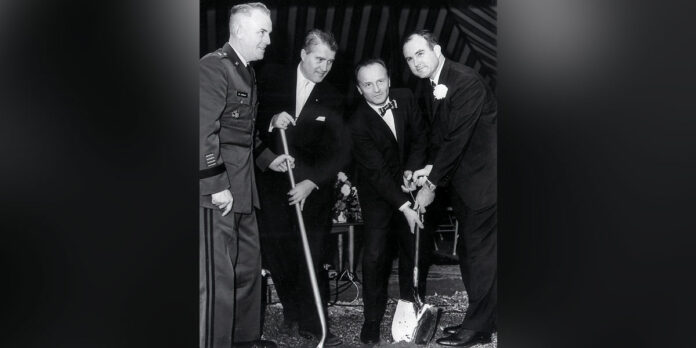HUNTSVILLE — Sixty years ago today, the state of Alabama took a momentous step forward in being a major player for space age opportunities with the establishment of a research institute at the University of Alabama in Huntsville – at the time a fledgling university adjacent to Redstone Arsenal.
Those were the thoughts spoken by Dr. Wernher von Braun, the director of Marshall Space Flight Center, during the Dec. 20, 1962 groundbreaking ceremony
“I am delighted to be present at this historic groundbreaking ceremony,” he said. “By this act, Alabama is swinging wide its doors to space age opportunity.”
The Marshall Star, Marshall Space Flight Center’s newsletter, detailed the institute’s mission to “provide basic research service in problem areas encountered at Marshall Space Flight Center and the U.S. Army Ordnance Missile Command.”
The institute also served to expand and strengthen the university’s graduate academic
programs.
Since that meager start, UAH’s Research Institute has expanded its scope of research
capabilities and supported graduate education thus contributing to the community’s advanced workforce development for decades.
“The University of Alabama in Huntsville has gained a national reputation among the elite
universities in the nation as a result of a broad critical mass that has been generated over more than a half century,” said Bob Lindquist, UAH vice president for Research and Economic Development. “The large cachet of partnerships with the federal agencies at Redstone Arsenal, the talent that has been recruited to the campus in addition to the investment in unique tools, has been recognized by prestigious organizations such as the National Science Foundation, and the Carnegie Classification of Institutes of Higher Education.”
Today, UAH’s Research Institute continues to carry out applied research and engineering
programs, principally to meet the needs of Department of Defense and NASA customers, but with significant related work for other government agencies and industry.
Some Research Institute efforts are carried out in close cooperation with customers, either on site or at government laboratories. The institute staff has expertise in covering the life cycle of aerospace, homeland security, industrial, and defense systems. These include systems engineering and project management, technical risk assessment, software engineering, and modeling of business processes, including supply chains.
In addition, the Research Institute offers expertise in the development and management of
international projects and in organizational design and the management of research
professionals. The facility operates a laboratory for studying the interactions of hardware with its environment at a wide spectrum of speeds, including hypersonics, and has the capability to measure high velocity impact phenomenology.
“The establishment of the Research Institute at UAH was a pivotal moment in Huntsville’s
growth to become an aerospace heavyweight,” said Erin Koshut, executive director of Cummings Research Park. “As Cummings Research Park celebrates 60 years this year too, we are proud of the continued investment and strong research that comes out of UAH and
specifically the Research Institute.”
The 1962 groundbreaking was the culmination of lobbying efforts in Montgomery by von
Braun, Army Gen. John Medaris and Huntsville community leaders.
“Opportunity goes where the best people go, and the best people go where good education goes,” von Braun told a joint session of the Alabama Legislature in 1961. “To make Huntsville more attractive to technical and scientific people across the country — and to further develop the people we have now — the academic and research environment of Huntsville and Alabama must be improved.”
Medaris spoke to the Alabama Legislature two years earlier.
“The fundamental requirement is to create graduate study and research centers to provide and sustain the scientists and engineers, whose efforts in turn will advance basic knowledge, and exploit that knowledge to promote our total progress,” he said in his remarks to support the Research Institute. “Such centers must have the faculties, and the facilities with which to carry on significant research for the mutual support of graduate studies and of modern industry.
“Without a continuing supply of new knowledge, industry would stagnate and the nation would face ruin.”
The lobbying resulted in a $3 million bond issue to construct a building to house the research institute. Officials leading the December 1962 groundbreaking included von Braun; Maj. Gen. Francis McMorrow, the first commanding general of the Army Missile Command; Rudolf Hermann, the first Research Institute director, and Alabama Gov. John Patterson.
“If our state can produce the No. 1 football team in the nation, and the No. 1 rocket and missile center, we can surely establish the No. 1 educational center for rocket and space technology – if we put our minds to it,” von Braun said.
As a nod to von Braun’s vision for the university, UAH is ranked fifth in the United States in federally funded aeronautical and astronautical engineering research, according to the National Science Foundation.
Read full Dr. Wernher von Braun remarks here.
Don’t miss out! Subscribe to our email newsletter to have all our smart stories delivered to your inbox.



